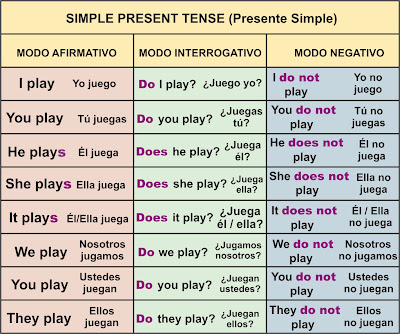🍉 Las wh-questions son las llamadas preguntas especificas porque no pueden responderse simplemente con un Si o un No.
miércoles, 22 de junio de 2022
WH - questions en presente simple
martes, 21 de junio de 2022
Present Simple
🌷 El present simple o el presente simple hace parte de los tiempos verbales del inglés.
💜Claves para usar presente simple💜
👻Cuando se quiere comunicar estados o acciones.
👻Cuando se quiere manifestar estados o situaciones que son rutinas o que se realizan periodicamente.
👻Cuando se quieren dar indicaciones, instrucciones y señales.
👻Cuando se quiere transmitir citas, hechos o compromisos que pasatan en un tiempo determinado.
💟Estructura💟
👾 Afirmativa: sujeto + verbo + complemento.
👾 Negativa: sujeto + auxiliar do/does not + verbo + complemento.
👾 Interrogativa: auxiliar do/does + sujeto + verbo + complemento.
sábado, 18 de junio de 2022
viernes, 17 de junio de 2022
Directions and location with prepositions
🐹 Los "Prepositions of location" son palabras que se utilizan para describir el lugar donde se encuentra un determinado bjeto en un momento determinado.
Prepositions of Place
🌸🍰 La palabra "At" nos muestra donde esta algo. no nos dice al lado, adentro, abajo o arriba. Simplemente muestra donde.
Usamos "AT" cuando hablamos de posiciones o ubicaciones
🍧 He is at the restaurant
🍧 She's at the office
🍧 He's at home
🍧 They met at a party
🍧 They are sitting at the table
🍧 He was standing at the window
Usamos "IN" cuando hablamos de una posicion dentro de otra cosa
🍪 The clohtes are in the closet
🍪 He's in the kitchen
🍪 They are talking in the street
🍪 She is lying in bed
🍪 There is a shark in the water
🍪 It was written in the newspaper
🍪 Chile is a country in South America
Usamos "ON" cuando una cosa esta adjunta o tocando otra
🍮 There is a mirror on the wall
🍮 There is a stain on his shirt
🍮 The books are on the shelves
🍮 He puts plates on the table
🍮 There is one candle on the cake
🍮 He likes riding on his horse
jueves, 16 de junio de 2022
miércoles, 15 de junio de 2022
Prepositions of Time - in, at, on
🍭 Las prepositions of time son aquellas particulas invariables que se utilizan para introducir aquella parte de la oracion que nos indica cuando sucede una accion (hora, un dia concreto, un momento determinado del dia, etc).
Como se utilizan:
🍓Usamos ON para dias y fechas en especifico
🍬 I will return it to you on Wednesday.
🍬 They got married on Friday the 13th.
🍬 we get paid on the 20th of every month.
🍬 I drank too much milk on New year's eve.
(Para fechas usamos numeros ordinales.)
🍓Usamos IN para meses, años. estaciones, siglos y periodos de tiempo especificos
🍨 My birthday is in january (solo se esta mencionando el mes)
🍨 My grandmother was born in 1927 (el año lo podemos leer como nineteen twenty - seven)
🍨 The river near my house is dry in Summer.
🍨 The company was founded in the 19th century.
🍨 we need to have this report ready in 15 minutes.
DIFERENCIAS
💜(In) The New Zealand National day is in February. (vemos que solo se esta mencionando el mes)
💛(On) The New Zealand National day is on February 6th. (aqui se menciona el dia y el orden en el que se escribe primero el mes y despues el dia es importante)
🍓Usamos AT con tiempos especificos (horas/minutos)
martes, 14 de junio de 2022
Adjectives
🌺 Estas son aquellas palabras que utilizamos para modificar o acompañar al nombre o sustantivo.
🌺 Usados para describir, ampliar, complementar o cuantificar el nombre en la oracion. nombran cualidades, rasgos, describen objetos ideas o personas.
🌺 En la mayoria de los casos anteceden al sustantivo.
Examples:
💜 He’s an excellent teacher
💜 She’s a wonderful mother
💜 It’s a terrible Tv
💜 It’s a beautiful garden
💜 She’s terrific dentist
💜 They’re not nice neighbors
💜 They’re good-looking colleagues
💜 It’s a fantastic phone
🍎🍎🍎🍎🍎🍎🍎🍎🍎🍇🍇🍇🍇🍇🍇🍇🍒🍒🍒🍒🍒🍒🍓🍓🍓🍓🍓🍓
lunes, 13 de junio de 2022
Wh questions
🌜 Las Wh Questions son un grupo de preguntas que se caracterizan porque en su nombre tienen la letra "wh" al inicio, excepto por uno de sus casos:
🌸 What (qué o cuál)
🌸 Why (por qué)
🌸 When (cuándo)
🌸 Where (dónde)
🌸 Who (quién)
🌸 which (cuál)
🌸 How (cómo)
domingo, 12 de junio de 2022
Verb "To Be"
👉 verbo to be que traduce "ser" o "estar"
🐱El verbo "to be" es el verbo mas importante del ingles y al mismo tiempo, el mas complicado. se utiliza tanto como verbo principal como un verbo auxiliar y es irregular en el presente y el pasado🐾
Affirmative





















%20GIF%20Animations.gif)


















